DAVID SCHOOLEY
CIVIL WAR & INDIAN WAR VETERAN
Indian War: Captain Twenty-fifth
U.S. Infantry Company E, (Buffalo Soldiers). Photo taken 1866.
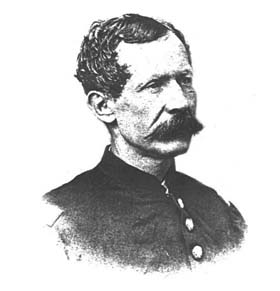
DAVID SCHOOLEY
CIVIL WAR & INDIAN WAR VETERAN
Indian War: Captain Twenty-fifth
U.S. Infantry Company E, (Buffalo Soldiers). Photo taken 1866.

It all began when Mr. Gabe Schooley, PR 11,
Gabe Schooley provided much of the twenty-fifth Infantry information and David Schooley's Indian Wars military
service movements.
I thank Mr. Schooley for his contribution, energy and patience, but most of all for the opportunity to present
David Schooley's military history. Without doubt, Gabe can proudly say David Schooley served with honor and distinction in both the Civil War and in the Indian Wars.
Captain David Schooley's Personal History
The Schooley family tree is traced back to the Ship Shield, which sailed from Stockton England and arrived at Burlington
New Jersey in December 1677. The manifest shows a Robert
Schooley, wife and children.
Captain David Schooley, who recruited Battery "M", Pennsylvania Artillery was the son of Isaac Schooley,
born April 12,
1824. He was born and raised on his father's farm. He went to local schools and later attended Wyoming
Seminary, where
he studied surveying, later engaging in that occupation. Much of his early manhood was spent in the Pittston
section, and it
was from there that nearly all his battery was recruited. He served through the war {his battery mustered on August
12,
1862}, nearly one year of which was spent in Confederate prisons, having been captured at Petersburg. After the
war he held
a commission in the Regular Army, and assisted in the U.S. Coast Survey and later spent 20 years at Army posts
in the west
with Co. E 25th Infantry. After his retirement from the Army, he returned to his home, and spent the remainder
of his life
there. He died January 17, 1910.
Captain Schooley was one of the outstanding men that this back of the mountain community has produced. He built
the plank
road between the cities of Wilkes-Barre and Pittston, and made a map of the seventeen townships of Luzerne County that is
an authority even today. Sometimes called eccentric, he nevertheless was a student, scholar and a gentleman.
Captain Schooley's background in engineering was used at his duty stations throughout the west. While stationed
at Fort
Davis, Captain Schooley and his company where responsible for the construction on the road between Fort Davis and
Hackberry or Mustang Ponds, TX via Limpia Canyon. In January 1876 Company was also at Wild Rose Pass Texas, once
again constructing the roadways for the Post.
Fort Davis, Texas
December 29, 1879
Letter to Colonel Grierson of the 10th Cavalry
From 1st Lt. Woodward 10th Cavalry
I have no news of importance. The garrison is all in except Schooley's company; he is still tinkering on the road.
I don't
think there will be any hill in the vicinity when he gets done.
Gabe Schooley
Exhibit Technician II
Fort McKavett State Historical Site
![]()
CIVIL WAR

Major David Schooley
Union: 2nd Pennsylvania Heavy Artillery
History of the Second Pennsylvania Heavy
Artillery: Sometimes referred to as Second Pennsylvania Veteran Heavy Artillery,
(112th
Regiment Pennsylvania Veteran Volunteers), and the "Second Heavy". Captain David Schooley is listed under
"Co. M".
The battle flag features a stylized emblem of the 18th U.S. Army Corps and the crossed
2nd Pennsylvania Heavy Artillery Regiment Battle Flag. Courtesy
of The Shenandoah 1863 Civil War Museum.
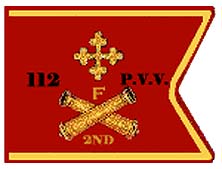
cannon of the artillery service branch, on a red field with gold trim. Company and
regimental designations are featured above and below the cannon. This particular guidon
was for Company F.
2nd Pennsylvania Heavy Artillery Volunteers
(112th Pa Regiment) Company M.
Includes Captain David Schooley's promotion to Major, names, rank, date of muster into service, term/years, remarks.
Praise for Captain David Schooley's regiment
_____________________________________________
2nd Heavy Artillery Regiment/112th Regiment Pennsylvania Volunteers
List of Engagements
Organized at Philadelphiaia January 8. 1862. (Cos. "D," "G" and "H" ordered to Fort Delaware January 9,
and duty there till March 19, 1862, when rejoined Regiment
in Defenses of Washington.) Companies "A," "B," "C," "E," "F,"
"I" and "K" moved to Washington, D.C., February 25, 1862. Attached to Artillery Brigade, Military
District of Washington, to August, 1862. Defenses of Washington north of the Potomac to October, 1862. 1st Brigade,
Haskins' Division, Defenses north of the Potomac, to February, 1863. 1st Brigade, Haskins' Division, 22nd Army
Corps, Dept. Washington, to March, 1864. 1st Brigade, DeRussy's Division, 22nd Corps, to May, 1864. 3rd Brigade,
2nd
Division, 18th Army Corps, Dept. of Virginia and North Carolina,
to December, 1864. Provisional Brigade, Defenses of Bermuda Hundred, Va., Dept. of Virginia and North Carolina,
to April, 1865. 1st Brigade, Ferrero's Division,
Dept. of Virginia, to May, 1865. Sub-District of the Blackwater, Dept. of Virginia, to January, 1866.
Service
Garrison duty in the Defenses of Washington north of the Potomac till May 27, 1864. (2 Independent Cos. Heavy Artillery
assigned as Cos. "L" and "M" November 24, 1862.) Moved to Port Royal, Va., May 27-28,
1864, thence marched to Cold
Harbor May 28-June 4. Battles about Cold Harbor June 4-12. Before Petersburg June
15-19. Siege operations against Petersburg and Richmond
June 16, 1864, to April 2, 1865. In trenches before Petersburg
till August 23, 1864. Mine
Explosion, Petersburg, July 30. Duty on the Bermuda Hundred front till September. Weldon Railroad August 18-21. Chaffin's Farm,
New Market Heights, September 28-30. Fair Oaks October 27-28 (Co.
"G"). Ordered to Bermuda front December 2, and
duty there till April, 1865. Fall
of Petersburg April 2. Duty at Petersburg till May, and in
counties of lower Virginia, Sub-District of the Blackwater, District of the Nottaway, till January, 1866. Mustered
out at City Point, Va., January 29. 1866, and discharged at Philadelphia, Pa., February 16, 1866.
Casualties and Losses
Regiment lost during service 5 Officers and 221 Enlisted men killed and mortally wounded and 5 Officers and 385
Enlisted men by disease. Total 616.
Source: Dyer, Frederick H. A Compendium of the War of the
Rebellion, Vol. III, Dayton, OH: Morningside, 1959.)
_____________________________________________
2nd Provisional Heavy
Artillery Regiment/ Pennsylvania Volunteers
Extended Learning Activity:
Independent Research- Discover the events leading to Captain Schooley's, capture and to his release. What were his
experiences as a prisoner of war? Were officers treated better than enlisted men? Begin at
Schooley, D., Captain, 2 Artillery, 01-Jul-64 @ Petersburg, VA.
Organized: April 20, 1864, from surplus men of the 2nd Regiment Heavy Artillery. Attached to Provisional
Brigade, 1st Division, 9th Army Corps, Army Potomac, to June, 1864. 3rd Brigade, 1st Division, 9th Corps, June,
1864. 2nd Brigade, 1st Division, 9th Corps, to August. 1864.
Service & Images
Campaign from the Rapidan to
the James May 4-June 12. Battles of the Wilderness, Va.,
May 5-7; Spottsylvania
May 8-21; North Anna River May 23-26.
Line
of the Pamunkey May 26-28. Totopotomoy May 28-31. Cold
Harbor June 1-12. Before Petersburg June 15-18. Siege of Petersburg till August 20. Mine Explosion, Petersburg,
July 30.
Regiment disbanded August 20, 1864, and rejoined original Regiment September 5, 1864.
Source:
Dyer, Frederick H. A Compendium of the War of the Rebellion,
Vol. III, Dayton, OH:
Morningside, 1959.)
_____________________________________________
Pvt. John J. Beam, 2nd Pennsylvania Heavy Artillery, Schooley's
Battery in Sgt.'s uniform. Courtesy of Michigan in the war organization.
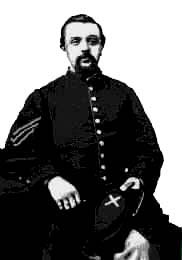
This photo was taken in a New York studio known as Pen-Yar. There is a hand written note
(on one of the 2 known copies that "John was a private and must have borrowed the Sergeant uniform".
The photo was used by Margaret Beam to obtain a widow's pension. Courtesy of Mary Worthington.
Photo Collection from the Army Military History Institute
2nd Regiment Pennsylvania Volunteer Heavy Artillery (112th Pa Regiment)
GARVIN Patric Catholic Cemetery, Corsicana [no dates] Company E, 2nd Pennsylvania Heavy Artillery.
Petersburg National Battlefield: African American Soldiers Confederate slave and forced
labor.
Civil War: PA Service Personnel
Buried at Petersburg National Battlefield, VA.
Prisoners of Petersburg Post-visit Lesson
Popular Grove National Cemetery
The National Park Service manages 14 National Cemeteries, all but one of which is related
to a Civil War battlefield park. The NPS is planning on listing all names of burials in these cemeteries on the
Civil War Soldiers and Sailors System. The first phase involves data taken from written records of Poplar Grove
National Cemetery at Petersburg National Battlefield, and also includes images of the headstones.
_____________________________________________
There are two listings. The first, by Unit, and the second, alphabetically.
UNIT LISTING
Soldier Name Unit State Military Grave Number
Organization
...ossley, John H. 2nd Pennsylvania Heavy Artillery 1055
Arny, J. 2nd Pennsylvania Heavy Artillery 1039
Bartly, J.L. 2nd Pennsylvania Artillery 3407
Bonner, Robert 2nd Pennsylvania Heavy Artillery 1031
Brown, William 2nd Pennsylvania Heavy Artillery 1037
Cahil, Kurn? 2nd Pennsylvania Heavy Artillery 5143
Chelson, John. W. UNKNOWN Pennsylvania Artillery 1074
Davis, George W. 2nd Pennsylvania Heavy Artillery 1059
Davis, Samuel 2nd Pennsylvania Heavy Artillery 1041
Gantz, Peter 2nd Pennsylvania Heavy Artillery 1054
Green, A. 2nd Pennsylvania Heavy Artillery 1032
Green, Norman 2nd Pennsylvania Heavy Artillery 5141
Hadsell, J.C. 2nd Pennsylvania Heavy Artillery 1056
Hornbaker, J.W. 2nd Pennsylvania Heavy Artillery 1033
Horsh, Michael 2nd Pennsylvania Heavy Artillery 5142
Johnson, Thomas 2nd Pennsylvania Heavy Artillery 5144
Kertry, John 2nd Pennsylvania Heavy Artillery 3411
Kresge, C. 2nd Pennsylvania Heavy Artillery 1061
Lane, M. 2nd Pennsylvania Heavy Artillery 1038
Mc...., Henry 2nd Pennsylvania Heavy Artillery 1057
Metz, George 2nd Pennsylvania Heavy Artillery 3412
Norton, James B. 2nd Pennsylvania Heavy Artillery 5123
Pearson, John 2nd Pennsylvania Heavy Artillery 1034
Reary, J. 2nd Pennsylvania Heavy Artillery 1035
Reed, James 2nd Pennsylvania Heavy Artillery 1060
Sharp, Thomas C. 2nd Pennsylvania Heavy Artillery 5140
Sheen, John 2nd Pennsylvania Heavy Artillery 1058
Steinour, D. 2nd Pennsylvania Heavy Artillery 1040
Thomas, Christopher 2nd Pennsylvania Heavy Artillery 3
UNKNOWN, UNKNOWN 2nd Pennsylvania Heavy Artillery 5373
Urbauch, G. 2nd Pennsylvania Heavy Artillery 1036
Van..., Lewis 10th Pennsylvania Heavy Artillery 1070
White, Edward W. 2nd Pennsylvania Heavy Artillery 1042
Zeller, Samuel 2nd Pennsylvania Heavy Artillery 2
ALPHA ROSTER
...ossley, John H. 2nd Pennsylvania Heavy Artillery 1055
2nd Pennsylvania Heavy Artillery Schooley's Battery
_____________________________________________
U.S. Civil War Regimental Histories in the Library of Congress.
Union Troops: Pennsylvania Heavy Artillery, 2nd
Source: Library of Congress.
Author: Ward, George Washington.
Title: History of the Second Pennsylvania Veteran Heavy
Artillery (112th Regiment Pennsylvania Veteran Volunteers)
from 1861 to 1866 [microform] / by George W. Ward.
Published: Philadelphia, Pa. : G.W. Ward, 1903.
Description: 146 p., [1] leaf of plates : ill., port. ; 24 cm.
LC Call No.: Microfilm 87/7340 (E)
Notes: Call number of original: E527.7.2d.
Master microform held by: DLC.
Microfilm. Washington, D.C. : Library of Congress
Photo duplication Service, 1987. 1 microfilm reel ; 35 mm.
Control No.: 3853825
_____________________________________________
Author: Ward, George W[Washington], 1845- [from old catalog]
Title: History of the Second Pennsylvania veteran heavy
artillery (112th regiment Pennsylvania veteran volunteers)
from 1861 to 1866,
Published: Philadelphia, Pa., G.W. Ward, 1904.
Description: 1 p.l., 146 p. illus., port. 24 cm.
LC Call No.: E527.7 2d
Subjects: United States -- History -- Civil war, 1861-1865
-- Regimental histories -- Pa. art. -- 2d. [from old catalog]
Pennsylvania artillery. 2d reg., 1861-1866. [from old catalog]
Control No.: 7264357.
![]()
|
INDIAN WAR |
Drawing from the ranks of those officers who served in the Civil War with distinction
the commanded of the Twenty-fifth Infantry was assigned to Colonel Joseph A. Mower, Lieutenant Colonel Edward Hinks
and Major Zenas R. Bliss.
Exerpts from "The Army of the United States
Historical Sketches of Staff and Line
With Portraits of Generals-In-Chief"
Twenty-fifth Regiment of Infantry
By Lieut. Geo. Andrews, 25th U. S. Infantry
Lieut.-Col. George L. Andrews, Courtesy of Ft. Clark.
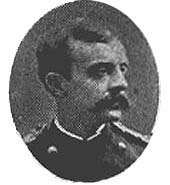
"The field officers will be: Joseph A. Mower, colonel; Edward W. Hinks, lieutenant colonel;
Zenas R. Bliss, major." "By the end of April, 1869, the organization of the regiment had been completed
and the special return shows a full complement of officers and 1045 men. Colonel (and Bvt. Major-General) Mower
was commanding the 1045 men."
Chaplins of the 25th Infantry (First 14 years)
1st Chaplain of the 25th Infantry:
Excerpt from National Park Service
"David E. Barr was
rector of St. John's Protestant Episcopal Church in Baton Rouge, Louisiana when the Civil War broke out. A Northern
sympathizer, he fled to New Orleans where he began to minister to Union troops in camps and hospitals. In 1865-66,
he served as the regimental chaplain of the 81st U. S. Colored Infantry Regiment. When the Thirty-ninth Infantry
was established in 1866, Barr became its chaplain. With the consolidation of the Thirty-ninth and Fortieth U. S.
Infantry regiments in 1869, Barr became the first chaplain of the newly formed Twenty-fifth Infantry. Chaplain
Barr served at Fort Davis in the spring and summer of 1872. For lack of a schoolroom, the chaplain held classes
outside in good weather and during periods of inclement weather in his own quarters."
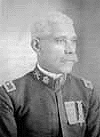 |
| 2nd Chaplain of the 25th Infantry: Col. Allen Allensworth A. M., Ph. D. Founder of the historical town of Allensworth. |
| 3nd Chaplain of the 25th Infantry: Rev. Theophilus G. Steward, D.D. |
Initial recruiting efforts concentrated on filling recruitment quotas with little regard
for the recruit's capability and soldiering skills. These recruits had to be discharged and replaced, causing a
delay in some regiments arriving at their assigned posts."
_____________________________________________
The Order to Create the Twenty-fifth Infantry Band.
Order creating the 25th Infantry Band. Courtesy Fort McKavett.
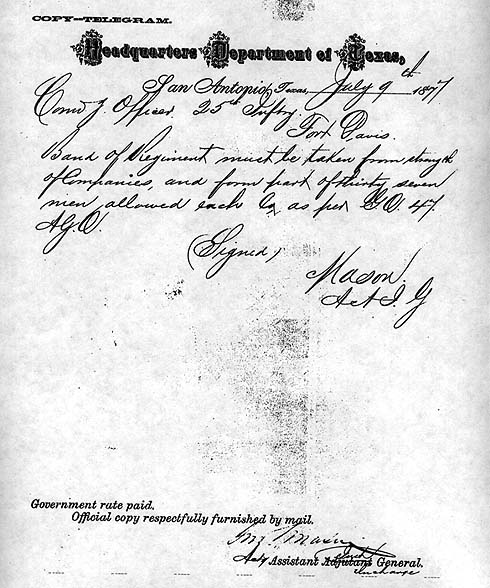
Michael A. Truber's 1st Enlistment as Head Musician. Courtesy
of Ned Braatz.
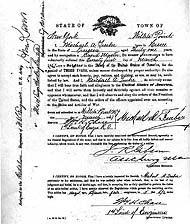
The order to create the Twenty-fifth Infantry
included the creation of its band. The band's first Head Musician was Michael A. Truber, who like Captain Schooley
served in the Civil War. Truber served in the 25th Infantry for 13 years.
_____________________________________________
"Colonel (and Bvt. Major-General) Mower was commanding the Department of Louisiana with headquarters at New
Orleans; Lieutenant-Colonel (and Bvt. Brigadier General) Hinks commanded the regiment with headquarters, Companies
D, G and K, at Jackson Barracks, La.; Major (and Bvt. Lieut.-Col.) Bliss with Companies E, F and I garrisoned Ship Island, Miss.; Company A was at Fort
Pike; La.; Companies B and H at Fort
Jackson, La.; Company C at Fort
St. Philip, La. By the end of the year, 532 men had
been discharged by expiration of service alone, and as little recruiting was done, the effective had fallen to
about 500 men, from which it has not since varied materially.
General Mower died at New Orleans January 6, 1870, and was succeeded by Colonel (and Bvt. Major General) J. J.
Reynolds who was placed in command of the Department of Texas the following April, without having joined the regiment.
In May, 1870, the regiment was on its way to that department, going by steamer to Indianola, Texas, thence marching
to San Antonio. Colonel Bliss with Companies B, C and G arrived at the latter place on June 3 and encamped at San
Pedro Springs where they were joined by the rest of the regiment, under General Hinks, on the 9th. The march to
stations began June 22d. The main body took the Fort Clark road, while Companies C and H diverged on the road to
Fort McKavett. At Rio Frio, Companies E and I marched for Fort Duncan, under Colonel Bliss. July found Headquarters,
Companies D and F established at Fort Clark; Company K at Fort Stockton; Companies A and G at Fort Davis; Company
B did not reach its distant station, Fort Quitman, until August.
In December, 1870, General Reynolds transferred to the 3d Cavalry and General Hinks retired from active service;
they were succeeded by Colonel John D. Stevenson and Lieut.-Col. George L. Andrews; the latter becoming
colonel of the regiment January 1, 1871, vice Stevenson resigned. Colonel Andrews joined the regiment at Fort Clark
June 19, 1871. In May, 1872, the regiment marched to Western Texas and established its headquarters at Fort Davis.
Company I, Captain Lawson commanding, participated in the engagement with Indians at Wichita Indian Agency, Ind.
Ter., Aug. 22 and 23, 1873, having one man wounded. Company B, Captain Bentzoni
commanding, was with General Mackenzie's expedition into Mexico in June 1878."
Col. Mackenzie, Courtesy of The National Archives.
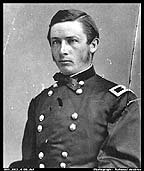
In 1875 Lieutenant Colonel William Shafter, led an expedition to the Llano Estacado region for two purposes: to
clear the Llano Estacado of renegade Comanches and make a detailed map of the region. One of the reasons the Llano
Estacado provided a refuge for the Comanches was its vast and hostile expanse. The expedition included troops from
the 24th Infantry, 10th Cavalry, one company from the 25th Infantry, and two companies of Indian scouts.
Excerpt from, "A Historic Context
for the African American Military Experience",
U.S. Army Construction Engineering Research Laboratories (USACERL)
"The expedition departed Fort Concho 2 months later and headed north to the Fresh Fork of the Brazos River
where a supply camp was established. While the Cavalry and Indian scouts set out to the west, chasing Comanches
and destroying Native villages, the Infantry remained for the most part at the supply camp." "A few detachments
of infantry were sent out to the southwest on scouting patrols. After being in the field for nearly 5 months, Shafter's
expedition returned to Fort Duncan
in late November 1875. By demonstrating that the Llano Estacado was not impenetrable,
Shafter - with the help of the African American soldiers - destroyed a sanctuary for the Comanches and opened that
region to settlement by whites. The map that resulted from the 1875 expedition became the standard for more than
30 years (Fowler 1971:32-33; Leckie 1967:143-148; Muller 1972:24-26).
Lt.-Colonel William Shafter, Courtesy of National Park Service.
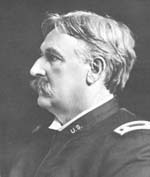
In the Spring of 1876, the Army received tacit authorization to cross the Rio Grande into Mexico when in pursuit
of raiders. Kickapoo and Lipan Indians were the first to suffer from this new policy. Throughout the rest of 1876
and into 1877, the U.S. Army crossed the Rio Grande repeatedly (Utley 1973:11-12).
In the Summer of 1876, Shafter organized an expedition of troops of the 8th and 10th Cavalry and companies of the
24th and 25th Infantry to cross the Rio Grande above the Pecos into Mexico, in search of Native American villages.
The role of the infantry on this campaign was to guard the railroad crossing over the Rio Grande. The expedition
did manage to destroy some villages but also enraged the Mexican citizens. The United States troops recrossed the
Rio Grande with the Mexican Army virtually on their heels (Leckie 1967:149-150; Muller, 1972:26-28)."
The history of the ten years' service in Texas is the record of a continuous series of building and repairing of
military posts, roads and telegraph lines; of escort and guard duty of all descriptions; of marching and counter-marching
from post to post, and of scouting for Indians which resulted in a few unimportant skirmishes."
Typical Duties. The main function of the infantry on the western frontier was to provide support to the cavalry.
The infantry was not well suited or equipped to fight Native Americans. Even the cavalrymen had trouble catching
them; the infantry had no chance. On occasion the infantrymen were mounted and assigned to scouting patrols, but
mostly their duties consisted of guard and fatigue details, fort repair, and escort assignments.
One of the black troops' most frequent tasks was guarding the stage lines' remount stations located on the roads
between the forts and frontier towns. Remount station guard duty was generally quiet, and a welcome relief from
the routine of garrison life. Most of the stages carried mail and freight, but if there were white passengers,
stationmasters frequently refused to allow off-duty black infantrymen to board the stage.
This discrimination led Colonel William Shafter, one of the officers of the 24th Infantry, to threaten the stage
companies with the removal of the guards if they continued to mistreat his troops. Government supply trains and
survey parties also relied on the protection of the infantry. Constructing roads and stringing telegraph lines
were duties that often fell to the infantrymen.
Two notable achievements during this period which had immediate and long-term consequences for the establishment
of peace on the West Texas was the work of Second Lieutenant George Andrews and the men of Company I and that of
Captain David Schooley and the men of Company E.
Second Lieutenant George Andrews and Company I constructed 914 miles of telegraph line from Fort Davis to Fort Bliss. This completed
the vital communications link from Fort Concho to Fort Davis which was an important component of
Colonel B. H. Grierson's campaign to remove those Apaches still committing depredations
in West Texas.
The other major event which had major military, communication and economic importance was the construction of new
roads through Wild Rose Pass
and Musquiz Canyon
under the command to Captain David Schooley by
the men of Company E Twenty-fifth Infantry. The importance of these road building activities in connecting the
forts and camps are evident to the military's objectives. Historically these roads became the blue prints for the
routes future highways and roads were to follow.
A detachments from the 25th Infantry frequently accompanied government trains as protective escort in route to
Tularosa, New Mexico
to pick up lumber for the fort.
With the establishment of new roads and the telegraph, came increasing numbers of towns and communities along the
Mexico-United States border. The need to protect American citizens from Mexican bandits, cut-throats, and marauders
became increasingly apparent. On December, 1876 a large contingent of the 25th regiment was ordered to Presidio del Norte where they
successfully ended the depravations.
Two new duties not necessary (or possible) on the Texas plains did occupy some of their time: cutting wood and hauling it back to the forts for heating and cooking fuel, and protecting
railroad tie-cutting crews (Fowler 1971:51).
_____________________________________________
Post Returns for Fort Davis, Texas:
This information was taken from the Post Returns for Fort Davis, Texas. Courtesy Gabe Schooley PR 11 Fort McKavett SHS a relative of Captain Schooley. Genealogical research is still
in progress, with emphasis on Captain David Schooley's personal and family history.
Captain David Schooley
25th U. S. Infantry Company E, (Buffalo Soldiers) 1872-1880.
"Walk-A-Heaps" (Name given by Indians)
Military Service:
May 1872 - First assigned to Fort Davis. Per S.O. 47 of March 9, 1872. Headquarters and Band and Companies C, D, E, H, and I of the 25th Infantry left Fort Clark, Texas on May 3, 1872 enroute to Fort Davis and other posts in Texas. Arrived at Fort Stockton, Texas on May 20 where Companies F and I were directed to take post. On the 23rd the march was resumed with the four remaining companies and headquarters arriving at Fort Davis on May 26, 1872. Captain Schooley did not arrive with his company (Company E) on May 26. Per S.O. 45 from the Post of Fort Clark dated March 22, 1872, he was on "Detached service"conducting prisoners to Baton Rouge, La from March 25, 1872 to April 14, 1872. Per S.O.380, he was granted "leave for four months" beginning on April 14.
August 1872 - Schooley "rejoined with leave" on August 18, 1872 at Fort Davis, Texas and assumed command of his company on August 19, 1872. From August 1872 until December of 1873, Schooley is listed as being at the post and commanding his company.
January 1874 - The Post Returns for this month list Schooley and his company on Detached Service at Fort Quitman.
February 1874 - He is listed at Fort Davis and commanding his Company from February 1874 to July 1874.
August 1874 - Schooley is listed "with Company at Fort Concho, Texas since August 2, 1874."
He is listed on the Post Returns as "temporarily" at Fort Concho on the September, October and November returns.
December 1874 - Schooley is listed as "on Detached Service enroute to Fort Davis since November 21, 1874" from Fort Concho.
January 1875 - The Post Returns for Fort Davis list Schooley as "commanding Company at Fort Concho, Texas joined from Detached Service, January 4, 1875."
February 1875 - "Commanding Company at Fort Concho, Texas".
March 1875 - "Company E, 25th Infantry. This company changed stations in compliance with S.O. 32, Headquarters, Dept. of Texas, dated February 17, 1872. Left Fort Concho, Texas under command Major Z. Bliss, 25th Infantry, March 11, 1875, where it had been stationed on temporary duty 1874 and arrived at its permanent post, Fort Davis, Texas on March 24, 1875."
April 1875 - Schooley is listed at Fort Davis in Company on the April, May, June, 1875 returns.
September 1875 - He is listed as commanding company on "Detached Service" from September 4 to 10, Del Norte, Texas per S.O. 130 Headquarters, Fort Davis, September 2, 1875.
October 1875 - On the October, November, and December returns, Schooley is listed as at the post commanding company.
January 1876 - "Company E." 25th Infantry left Fort Davis, Texas to permanent station on January 24, 1876 for the purpose of changing and repairing the road between Fort Davis and Hackberry or Mustang Ponds, Texas via Limpia Canyon per S.O. Headquarters, Fort Davis, Texas dated January 22, 1876.
On the same return, Schooley is listed as absent on Detached Service "commanding January 24, 1876 at Wild Rose Pass, Texas." He was also listed on "Detached Service" From January 12-20, 1876 "making survey of proposed road between Fort Davis and Heads ranches."
The February and March returns list him as at Rose Pass, Texas in command of Company E that was "engaged in building a road to that place."
April 1876 - Schooley and Co. E returned from Wild Rose Pass, Texas Detached Service in April.
May 1876 - At post - commanding company
June 1876 - On Detached Service as a witness before U. S. Court at Austin Texas, from June 7-22, 1876.
June 7, 1876 - Left post, on leave for four months beginning June 22, 1876.
October 1876 - Leave extended one month
December 1876 - Leave extended one month
January 1877- "On Detached Service from January 15 to January 17, 1877 with cavalry recruits at San Antonio."
"At San Antonio as a member of a General Court Martial since January 17, 1877."February 1877 Enroute to Fort Davis to join post.
March 1877 - Commanding Company since March 12, 1877 - joined from detached Service same date. Returns for April and May 1877 list him at the post, commanding company
June 1877 - "On Detached Service scouting from June 7 to June 12, 1877."
"Company E, 25th Infantry - pursuant to Orders 119, Fort Davis, Texas, July 27, 1877 - relieved of duty at Fort Davis and ordered to proceed to Fort Clark. Left post at 3:30 p. m.
July 30, 1877 - " Schooley in command.
There is no mention of Schooley or Co. E on Post Returns from July 1877 through February 1878.
March 1878 - "Company E, 25th Infantry. The company left Fort Duncan, Texas on March 4, 1878 and arrived at its destination, Fort Davis, Texas on March 29, 1878. Distance march 385 miles. Schooley in command.
April 1878 - Schooley is listed on "scouting duty from April 21, 1878 to April 30, 1878."
May & June 1878 - He is listed as commanding company - at post.
July 1877 - At Austin, Texas as a witness before the U. S. District Court since July 8, 1878, orders 89, Fort Davis, Texas, July 7, 1878. Relieved of command July 8, 1878
August 1878 - Joined from Detached Service on August 3, 1878
The Post Returns for September 1878 through April 1879 list Schooley as at the post and commanding company.
May 1879 - Commanding Company at Musquiz Canyon, Texas since May 1, 1879 about six miles distant where it is at present engaged in constructing a road. Schooley and Company E remained at Musquez Canyon from May 1879 until January 1, 1880.
January 1880 - At post - commanding company Schooley and Company E remained at Fort Davis until May 17, 1880 when they left enroute to San Antonio as the regiment was being transferred to the Department of Dakota.
AN APPRECIATION OF THE REGIMENT'S WORK IN TEXAS, 1870-1880-Colonel, 4th Cav. COMMENDATORY ORDER FROM COMMANDING
OFFICER, DISTRICT OF PECOS-GENERAL ORD'S
RECOMMENDATIONS-THE REGIMENT MOVES TO THE DEPARTMENT
OF DAKOTA-MOVE TO FORT SNELLING-ABANDONMENT OF FORT HALE-AN INSPECTION REPORT.
The record of the regiment's ten years of service in Texas (1870-1880) is not, on the whole, an exceptionally eventful
one, but it is one of hard work cheerfully done and duty well performed, and that these services were appreciated
by the powers that be, let the from the General of the Army, pro- following order testify:
Excerpt from:
Headquarters District of the Pecos
Fort Concho, Texas, February 7, 1881.
General Orders
No. 1:
In pursuance of orders this day received, abolishing all Military Districts in
the Department of Texas, having stated in his Department of Texas, the undersigned relinquishes command of the
District of the Pecos.
In doing so it is proper to refer to the services rendered by the officers and soldiers of the 10th
Cavalry, and those of the 24th and 25th Infantry, who participated in the arduous ability and
determination to put a stop work and active field operations of the past three years.
In addition to the work at posts and sub-posts on barracks and quarters, and in guarding mails and other public
property throughout the district, over one thousand miles of wagon roads and three hundred miles of telegraph lines
have been constructed and kept in repair by the labor of the troops, a vast region thoroughly scouted over, minutely
explored, its resources made known, and wonderfully developed.
The distance marched by companies and detachments during the three years specified, as shown by the records, foots
up the grand total of one hundred and thirty-five thousand seven hundred and ten (135,710) miles.
Much credit is due the troops who took part in the hard work, explorations, active scouting, expeditions against
the Mescalero Apaches, and especially to those engaged in the campaign against Victorio and his band of hostile Indians who were outmarched, out-maneuvered,
repeatedly headed off, disconcerted, met face to face, squarely fought, severely punished, driven into Mexico,
badly crippled and demoralized, where-no longer able to hold together as an organized force-they fell an easy prey
to the attack of the Mexican troops and Indian scouts from the Sierra Madre.
A settled feeling of security, heretofore unknown, prevails throughout western Texas, causing a rapid and permanent
increase of population and wealth of the state, which Assistant Adjutant General is gratifying to citizens, and
the military who have been instrumental in bringing about this very satisfactory condition of affairs.
The value of all this work to the great state of Texas, as cited herein, can hardly be overestimated.
It is a pleasant duty for me to thank the officers and enlisted men for the zeal
and alacrity with which they responded to every demand,-however much it may have tested their power of endurance,-for
the fortitude with which they braved dangers, and the intelligent activity and efficiency manifested in the discharge
of the duties assigned them. The gallantry displayed and meritorious services rendered, justly merit some special
and suitable recognition from the Government.
B. H. Grierson,
Colonel, l0th Cavalry,
Brevet Major General, U. S. Army.
|
Personal Links* |
| Buffalo Soldiers |
|
62nd & 65th Regiments U.S. Colored Troops, with History & Soldiers' Names* Co-founders of Lincoln Institute, later Lincoln University, Jefferson City, MO. Preservation Issues, Black Missourians in the Civil War, Co-founders of Lincoln Institute, later Lincoln University, Jefferson City, MO. The Battle of Glasgow- Includes 62nd Regiment USCT. "Additional Notes on the Battle of Glasgow on October 15, 1864." New research and maps; Excellent Missouri Civil War Museum-The museum mentions the creation of the 62nd U.S. Colored Troops, has interesting Civil War facts, Civil War terms, and photographs. Palmito Ranch, The Last Battle of the Civil War: A Gentleman's Agreement Broken* COLUMBIA CEMETERY Columbia, Missouri- The Columbia Cemetery could be the only known cemetery in Missouri in which United States Colored Infantry, Civil War Veterans are buried. You will find 31 graves from the following regiments; 2nd, 3rd, 11th, 13th, 18th, 54th, 56th, 60th, 62nd, 65th, 67th, and the 68th. They are in very poor condition. Civil War Medicine- Excellent War of the Rebellion Journal Contents (1880 - 1901)- The War of the Rebellion is a compilation of the official records of the Union and Confederate armies published under the direction of the Secretary of War. It includes all official General & Regimental communications. Helps to know the theater of war, unit, month and year. The United States Civil War Center-Thousands of links, including Native Americans Civil War Soldiers & Sailors System United States Army Military History Institute The Louisiana Native Guards- Excellent Site Black Civil War Soldiers of the Trans-Mississippi West Union Army Regimental Histories Cindi's List of African- American Sites American Indians In The Civil War Veteran Military Websites Military & Pension Records for Union Civil War Veterans Civil War Artillery Sites Educational Constitution of the United States-Biographies of the signing and non signing delegates to the Constitutional Convention, Bill of Rights, and much more. Excellent THE OVERLAND TRAIL: An Official Millennium Trail. This site is very comprehensive in its analysis of the everyday aspects of living and traveling in the West. Excellent Dive and Discover- eCLASSROOM- Travel thirty-eight states by motorhome, and experience their wonder and history through interactive experiences. Excellent 50 STATES.com - Complete information on each State Project Gutenberg - Download pre-1923 classic books from the start of this century and previous centuries, from authors like Shakespeare, Poe, Dante. Titles: Sherlock Holmes, Tarzan, Alice's adventures in Wonderland, and thousands of others. Excellent Library of Congress American Memory Lessons, Grades 4-12 Hperhistory Timeline - Click on the 3,000-year timeline to access relevant maps, biographies and profiles of people, places and events. Excellent Blue Web'n- The Wild, Wild West EduScapes -A Website for Life-Long Learners. Websites and Resources For Teachers Los Angeles County Schools- K-12 Lesson Plans VisionQuest St.Johns K-12, Fl. SJCSD Black History Websites Georgia Institute of Technology- K-12; Center for Education Integrating Science, Mathematics, and Computing Davenport Public Library Online-Learning- Learning Disabilities Brothers Judd A major source for good books, recommended reading, and tons of rated Website! Educational Resources Information Center ( Ask ERIC) and Other Clearinghouses POETRY- You'll find everything here. Federation of American Scientists- NASA- Photo Gallery; Excellent NASA- Ask the Hubble Space Telescope team a question. Excellent National Geographic- Excellent A WWW Vitural International Aborigious People- Excellent site with excellent photographs. Kathy Schrock's Guide for Educators Historically Black Colleges and Universities Native American Tribal Colleges & Universities Hispanic Association of Colleges & Universities Women's Colleges Smithsonian Institution Kidsweb Kids Domain Kids-online Yaho0ligans-A Web guide for kids Reach-it: A very useful site! www.gmsp.org. The American Veterinary Medical Association: Animal health, safety, buying, pet loss, careers, kid's corner Environmental Protection Agency-There is also a link for kids. TeachersFirst Search Engines-28* Shareware & Freebees Efortress Scholarships NAACP CSUS LIBRARY- Offers a multiplicity of services including, online applications for more than 1,700 undergraduate colleges, as well as graduate programs. National Achievement Scholarship The Minority On-Line Information Service (MOLIS) 2001 Colleges, College Scholarships, and Financial Aid page United Negro College Fund The American Indian College Fund The Paul & Daisy Soros Fellowships for New Americans Hispanic Scholarship Fund www.hsf.net www.gatesfoundation.org. Genealogy Afrigeneas Home Page Amistad Research Center American Historical Text Archive-This archive, housed at Mississippi State University, is international in scope. U.S. Colored Troops - Contains the names of over 230,000 soldiers of the USCT. New Orleans Public Library Pennsylvania Department: African-American genealogy Kentucky Department for Libraries and Archives -"Archival Reference Services", accepts certain written requests for genealogy searches. Josephculligan.com Hundreds of sources Government The Constitution of the United States: Full Text Pro-Handgun Control Anti-Handgun Control Civil War Soldiers & Sailors System Name Search- I found my grandfather by leaving out the Unit No. (or Ordinal) info. National Archives and Records Administration Genealogy & Soundex Locator Ordering Pension & Military Records Selected Civil War Photographs & Searchable Index Library of Congress The White House American Memory Library Environmental Organizations Web Directory-This site has everything on the topic from restaurants to solar vehicles. National Weather Service Local & World The Federal Population Censuses U. S. Census Bureau |
| BUFFALO SOLDIERS & INDIAN WARS* Topic Page Links. Page 1 101st Regt. United States Colored Infantry* Cherokees- The Seminole Nation Indian Territory- Colonel Allen Allensworth Five Civilized Nations Union Pacific Railroad- Treaty Of Medicine Lodge* Cheyenne-Arapaho- Comanches Kiowa tribes Brevet Major General George Armstrong Custer, Lieutenant Colonel General Philip Sheridan General William T. Sherman Page 2 Fort Laramie Treaty of 1868 * Chief Satanta Chief Quanah Parker Legendary Chiricahua, Chief Cochise Page 4 Chief Gull Little Bighorn Major Reno's Account Chief Crazy Horse's Monument Lipan, 6th-8th grades- Kickapoo Indians Richard Henry Pratt- Bibliography* Native American Photos of Native American scenes, and artifacts, with archival data.- Click on all paintings and photos to enlarge. Smithsonian Institution; Excellent MAPS: Geographical Information Systems- Twin Territories, Oklahoma-Indian Territory Project. Legendary Indian Leaders Speak American Indian Treaties, Law and Issues Legislative Impact: This site provides up to the minute information on tribal issues currently in legislation. The American Indian Page Native American Resources American Indians In The Civil War The United States Civil War Center: Thousands of links, including Native Americans. Bill's Aboriginal links-Provides a listing of international native sites. Excellent Early Native Americans Texas Maps ArtsEdNet Japanese-Asian Americans The National Japanese -American Historical Society Japanese-American Veteran'association The 442nd Infantry Regiment A History of the Japanese-American Internment Chinese Culture Net Chinese Language Information Page Asian Studies WWW Virtual Library The Center For Southeast Asian Studies Asian Art Asian Pacific American Medical Student Association Forts Fort Clark, Texas Fort Concho, Texas Fort Davis, Texas Fort Davis, West Texas Fort Gibson, Oklahoma Fort Griffin, Texas Fort Laramie, Wyoming Fort Larned, Kansas Fort McKavett, Texas Fort Scott, Kansas Fort Stockton, Texas International Light Horse Cavalry The 61 Cavalry- The only unmechanised mounted cavalry regiment in the world. The genesis of modern polo. Strathcona Museum Lord Strathcona's Horse (Royal Canadians) Regimental Museum Nintheenth Century British and Indian Armies- Very large photographic and genealogical resource for 19th century British and Indian armies, soldiers, and Anglo- Indians (India) families. K Troop The New South Wales Lancers- Allies WW1&2 |
You may FREELY link to this Web site and its PERSONAL LINKS*, for NON-COMMERCIAL or PERSONAL USE ONLY. Copyright restrictions apply to the use, transmission and reproduction of images and content on this page and its links. Any other use, without prior written permission of the copyright owners is prohibited. Buffalosoldier.net is not responsible for any losses due to linking to its Web pages and links.
Send e-mail to: sldavis@buffalosoldier.net
Copyright 2002 Stanford L. Davis, M.A.
All Rights Reserved
www.buffalosoldier.net